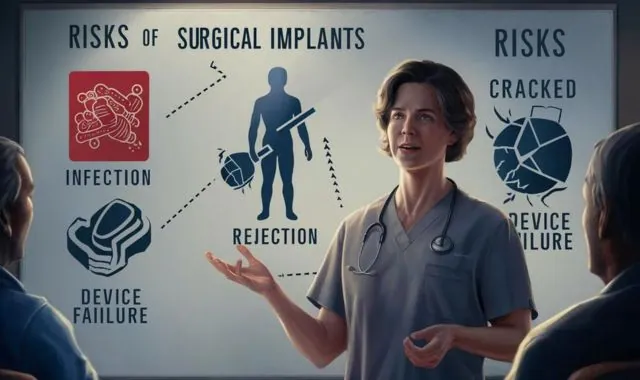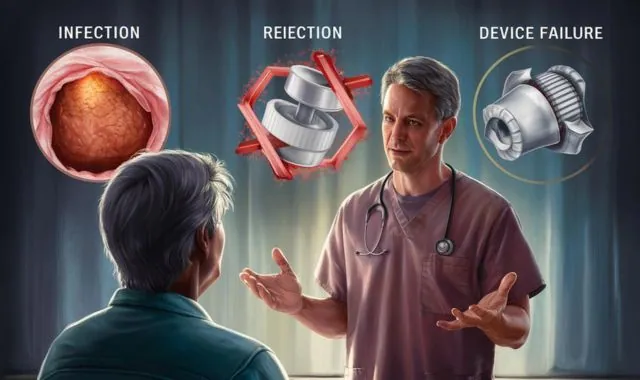Physical Address
304 North Cardinal St.
Dorchester Center, MA 02124

In today’s world of advanced medical technology, surgical implants are hailed as marvels of modern medicine.
These devices, now commonplace for various health issues, offer hope and salvation to countless individuals. From hip replacements to breast implants, these devices promise to restore function, enhance appearance, and even save lives. Yet, beneath the surface of these seemingly miraculous devices lies a darker reality.
In recent years, reports of complications, injuries, and lawsuits have shed light on the risks associated with surgical implants. As a consumer, understanding these risks is vital before making any decisions.
In this blog, we’ll look at the rise of medical implants, why they fail, and some tips to help you make the right choice if you decide to go under the knife.

In recent decades, surgical implant use has skyrocketed. The international medical implant market was valued at USD 111.33 billion in 2023. It is expected to reach USD 157.62 billion by 2028. North America continues to be the largest contributor to the market share, whereas Asia-Pacific is the fastest-growing market.
Advancements in medical technology, including better materials and minimally invasive surgery techniques, have made implantable devices safer, more effective, and available to a wider patient population. Moreover, a rise in the aging population and increasing demand for aesthetic procedures have also fueled the growth of this industry.
Today, millions of people worldwide rely on various types of implants, from joint replacements and cardiac pacemakers to breast augmentations and dental implants. The promise of restored function, enhanced appearance, and improved quality of life has made surgical implants attractive to many patients.
However, this rapid rise in popularity has also brought to light the potential dangers and complications associated with these medical devices.
Implant life depends on device type and materials. Some, like pacemakers, need replacement every few years, while others (like artificial hips,) may last decades. Discuss the expected lifespan with your doctor for the specific implant you’re considering.
Surgical implants, like any medical intervention, have inherent risks. Device failures come in different forms.
Common complications include infection, rejection, and device failure. Moreover, implants can also break within the body, migrate from their intended location, or cause other unexpected side effects. These issues can not only cause physical pain and discomfort but also take a significant emotional and financial toll on patients.
Imagine the distress of a woman who undergoes a breast augmentation only to have the implants rupture or the anguish of an individual who faces mobility challenges due to a failed hip replacement.
These malfunctions can be due to design flaws, manufacturing errors, or even improper use during surgery. The numbers are staggering– the FDA recalls hundreds of medical devices each year due to safety concerns. In 2023 alone, the FDA recalled over 60 such devices, whereas in 2022, the number was 60. As of 2024, the FDA has already recalled 26 devices.

This highlights the ongoing need for vigilance and underscores the importance of checking FDA databases for the latest recall information. Patients must be aware of the most common types of surgical implants, such as breast implants, hip and knee replacements, pacemakers, and more. Each type of implant has its risks and considerations.
For example, breast implants have been linked to a rare form of cancer, while metal-on-metal hip replacements have been associated with high failure rates and toxic metal ion release.
The Bard Power Port lawsuit is a prime example of the risks associated with faulty medical devices. This case highlights how even FDA-approved implants can fail, leaving patients with devastating consequences. The Bard Power Port, a small device used to deliver medications and draw blood, was found to have a high failure rate, leading to serious complications and, in some cases, even death.
Start by checking the FDA’s databases for recalls. Discuss your concerns with your doctor and research the company behind the device.
Be an informed patient every step of the way:
Insurance coverage for implants varies widely. Some medically necessary implants (like pacemakers or joint replacements) are usually covered. However, coverage depends on your insurance plan and specific policy. Always check with your insurer before the procedure to avoid unexpected costs.

Despite the challenges and risks associated with surgical implants, the future of surgical implants holds both promise and peril.
On the one hand, researchers are working to develop smaller, safer, more durable, and better-integrated implants that could revolutionize the way we treat a wide range of health conditions. Advancements in materials science, 3D printing, and smart technology could lead to implants that are less prone to complications and better able to adapt to the body’s needs.
“Smart” implants might contain sensors to monitor your body and alert your doctor of any issues. Additionally, 3D printing may allow custom-fit implants for each patient. The future also holds promise for biodegradable implant materials like polyether ether ketone (PEEK). This material dissolves over time, potentially reducing the need for additional surgeries. It also helps accelerate bone regeneration, thus reducing the patient’s recovery time.
These advancements hold great potential for improving patient outcomes and the overall experience with implanted medical devices.
while surgical implants offer tremendous benefits, it’s essential to remember that they are not without risks. While the future of these devices holds exciting possibilities, the cautionary tale of failed implants serves as a stark reminder that innovation must be balanced with rigorous testing, transparency, and accountability.
By being informed, proactive, and knowing your rights, you can partner with your healthcare team to make the best decisions for your health and well-being.